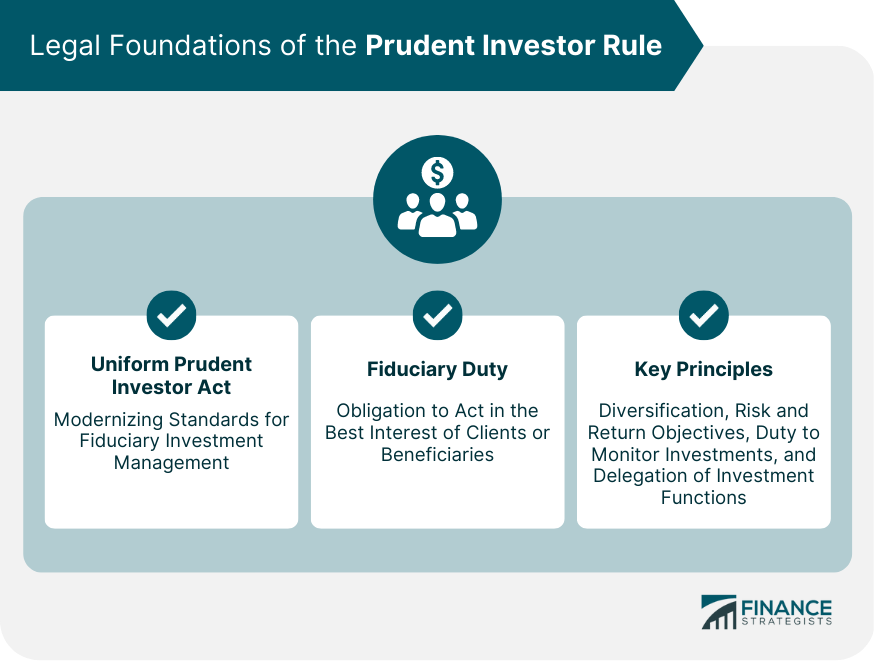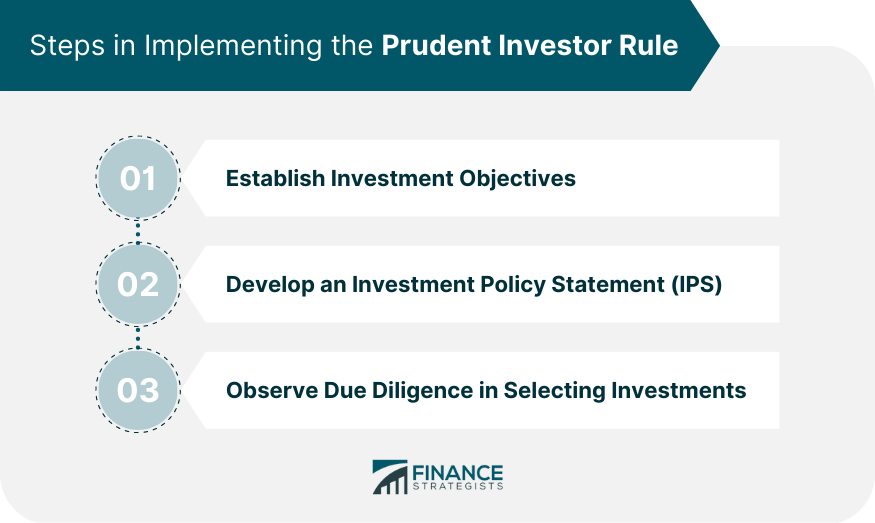The prudent investor rule is a legal guideline that governs the actions of fiduciaries, such as trustees and investment advisors, when managing investment portfolios. This rule emphasizes the importance of proper risk management, diversification, and a long-term investment strategy in order to meet the needs of beneficiaries. The Uniform Prudent Investor Act (UPIA) was adopted in 1994 by the National Conference of Commissioners on Uniform State Laws. The UPIA provides a legal framework for the prudent investor rule and has been widely adopted by states in the United States. It replaced the outdated "prudent man rule" and modernized the standards for fiduciary investment management. Fiduciaries has a legal responsibility to act in the best interest of their clients or beneficiaries. This duty encompasses the obligation to adhere to the prudent investor rule when making investment decisions. Fiduciaries must act with care, skill, prudence, and diligence, ensuring that the investments they choose align with the risk and return objectives of the beneficiaries. The prudent investor rule is built on several key principles, which include: 1. Diversification: Fiduciaries should create a diversified portfolio to minimize risk and maximize potential returns. 2. Risk and Return Objectives: Fiduciaries should carefully consider the risk tolerance and return objectives of beneficiaries when making investment decisions. 3. Duty to Monitor Investments: Fiduciaries must regularly monitor and review the performance of investments and make adjustments as necessary. 4. Delegation of Investment Functions: Fiduciaries may delegate investment management functions to professionals, provided they exercise due diligence in selecting and monitoring those professionals. In order to apply the prudent investor rule, fiduciaries must first establish clear investment objectives for the portfolio. These objectives should consider the time horizon, risk tolerance, and expected returns of the beneficiaries. The investment time horizon refers to the length of time the assets will be invested before being used by the beneficiaries. A longer time horizon allows for more aggressive investments, while a shorter time horizon may necessitate more conservative investments. Risk tolerance refers to the level of risk that the beneficiaries are willing to accept in pursuit of returns. Fiduciaries must consider the beneficiaries' financial needs and goals when determining an appropriate level of risk. Fiduciaries should establish return objectives that align with the risk tolerance and time horizon of the beneficiaries. These objectives will guide the selection of investments and the overall portfolio strategy. An Investment Policy Statement (IPS) serves as a roadmap for managing a portfolio in accordance with the prudent investor rule. The IPS should outline the asset allocation, selection of investment vehicles, and processes for monitoring and rebalancing the portfolio. The IPS should specify the target allocation of assets across various asset classes, such as stocks, bonds, and cash. This allocation should reflect the risk and return objectives of the beneficiaries. The IPS should provide guidelines for selecting investment vehicles, such as individual stocks, bonds, mutual funds, or exchange-traded funds (ETFs). The IPS should establish a process for regularly monitoring the performance of the portfolio and rebalancing the asset allocation as needed. Fiduciaries must exercise due diligence when selecting investments to ensure they are aligned with the beneficiaries' objectives and the principles of the prudent investor rule. This process involves: Fiduciaries should thoroughly research and analyze potential investments, considering factors such as historical performance, management team, fees, and risks. Fiduciaries should compare different investment options, evaluating how each one contributes to the overall diversification, risk, and return objectives of the portfolio. Fiduciaries must regularly monitor the performance of investments and make adjustments as necessary to maintain alignment with the IPS and the prudent investor rule. Diversification is a critical component of the prudent investor rule, as it helps to reduce risk and enhance return potential. The main benefits of diversification include: Risk Reduction: By investing in a variety of assets, fiduciaries can reduce the impact of any single investment's poor performance on the overall portfolio. Enhanced Return Potential: A diversified portfolio allows for exposure to a wider range of investments, increasing the potential for higher returns over time. Fiduciaries can achieve diversification through several strategies: Asset Classes: Spreading investments across different asset classes, such as stocks, bonds, and cash, helps to reduce the impact of fluctuations in any one asset class. Geographic Regions: Investing in assets from different geographic regions can reduce the impact of localized economic or political risks. Investment Styles and Sectors: Diversifying across various investment styles (e.g., value, growth, income) and sectors (e.g., technology, healthcare, consumer goods) can help mitigate risks associated with specific market segments. Despite the benefits of diversification, there are challenges that fiduciaries must consider: Correlation Risks: Investments that are highly correlated may move in the same direction during market fluctuations, reducing the benefits of diversification. Over-Diversification: Holding too many investments in a portfolio can lead to diminished returns and increased management complexity. Regularly monitoring and reviewing the performance of investments is an essential aspect of the prudent investor rule. This process involves: Regular Review of Portfolio Performance: Fiduciaries should periodically assess the performance of the portfolio to ensure it remains aligned with the beneficiaries' objectives and the IPS. Evaluating and Adjusting the Investment Policy Statement: Fiduciaries may need to update the IPS to reflect changes in the beneficiaries' risk tolerance, time horizon, or financial goals. Rebalancing the Portfolio: As market conditions change and investments grow or decline in value, fiduciaries may need to rebalance the portfolio to maintain the target asset allocation. Assessing and Managing Changes in Risk and Return Objectives: Fiduciaries should monitor changes in market conditions and the risk and return profiles of the investments, making adjustments as necessary to protect the beneficiaries interests. The investment landscape continues to evolve, presenting new challenges for the prudent investor rule: Impact of Low-Interest Rates and Economic Uncertainty: Persistently low interest rates and economic uncertainty have made it more challenging for fiduciaries to achieve desired returns without taking on excessive risk. The Rise of Passive and Algorithmic Investing: The growing popularity of passive and algorithmic investment strategies has changed the way many portfolios are managed, potentially impacting the application of the prudent investor rule. The Role of Environmental, Social, and Governance (ESG) Factors: The increasing focus on ESG factors has led to a greater emphasis on incorporating these considerations into investment decisions. Adapting the Rule to New Financial Instruments and Technologies: As new financial instruments and technologies emerge, fiduciaries must stay informed and adapt their investment strategies to maintain compliance with the prudent investor rule. The prudent investor rule provides a legal framework for fiduciaries to manage investment portfolios while ensuring that they act in the best interests of their clients or beneficiaries. The rule emphasizes the importance of proper risk management, diversification, and a long-term investment strategy to meet the needs of beneficiaries. The implementation of the rule involves establishing investment objectives, developing an investment policy statement, and observing due diligence in selecting investments. Diversification is a critical component of the prudent investor rule, helping to reduce risk and enhance return potential, and fiduciaries can achieve diversification through different strategies. However, challenges such as correlation risks and over-diversification must be considered. Regularly monitoring and reviewing the performance of investments is essential, and fiduciaries must adapt to modern challenges such as low-interest rates, algorithmic investing, ESG factors, and new financial instruments and technologies.What Is Prudent Investor Rule?
Legal Foundations of the Prudent Investor Rule

Uniform Prudent Investor Act (UPIA)
Fiduciary Duty in Investment Management
Key Principles of the Rule
Implementing the Prudent Investor Rule

Establishing Investment Objectives
Time Horizon
Risk Tolerance
Expected Returns
Developing an Investment Policy Statement (IPS)
Asset Allocation
Selection of Investment Vehicles
These guidelines should prioritize diversification, cost-efficiency, and the potential for long-term growth.Monitoring and Rebalancing
This may involve adjusting the portfolio to maintain the target allocation or making changes in response to changes in the beneficiaries' risk tolerance, time horizon, or financial goals.Due Diligence in Selecting Investments
Research and Analysis
Comparison of Investment Options
Ongoing Assessment of Investment Performance
Role of Diversification
Benefits of Diversification
Diversification Strategies
Challenges in Achieving Diversification
Importance of Monitoring and Reviewing Investments
Modern Challenges to the Prudent Investor Rule
Conclusion
Prudent Investor Rule FAQs
The prudent investor rule is a legal guideline that governs the actions of fiduciaries, such as trustees and investment advisors, when managing investment portfolios. It emphasizes proper risk management, diversification, and a long-term investment strategy to meet the needs of beneficiaries. The rule is important because it ensures that fiduciaries act in the best interest of their clients, protecting and growing their assets.
The Uniform Prudent Investor Act (UPIA) is a legal framework that provides the foundation for the prudent investor rule. Adopted in 1994 by the National Conference of Commissioners on Uniform State Laws, the UPIA modernized the standards for fiduciary investment management and has been widely adopted by states in the United States.
The key principles of the prudent investor rule include diversification (creating a diversified portfolio to minimize risk and maximize potential returns), risk and return objectives (considering beneficiaries' risk tolerance and return objectives when making investment decisions), duty to monitor investments (regularly monitoring and reviewing investment performance), and delegation of investment functions (fiduciaries may delegate investment management functions to professionals with due diligence).
Fiduciaries can implement the prudent investor rule by establishing clear investment objectives (time horizon, risk tolerance, and expected returns), developing an investment policy statement (IPS) that outlines asset allocation, selection of investment vehicles, and monitoring and rebalancing processes, and exercising due diligence when selecting investments by conducting thorough research, comparing investment options, and regularly assessing investment performance.
Some modern challenges to the prudent investor rule include low-interest rates and economic uncertainty, the rise of passive and algorithmic investing, the increasing focus on environmental, social, and governance (ESG) factors, and the emergence of new financial instruments and technologies. Fiduciaries can adapt to these challenges by staying informed, adjusting their investment strategies as needed, and ensuring that their portfolios remain aligned with the beneficiaries' objectives and the principles of the prudent investor rule.
True Tamplin is a published author, public speaker, CEO of UpDigital, and founder of Finance Strategists.
True is a Certified Educator in Personal Finance (CEPF®), author of The Handy Financial Ratios Guide, a member of the Society for Advancing Business Editing and Writing, contributes to his financial education site, Finance Strategists, and has spoken to various financial communities such as the CFA Institute, as well as university students like his Alma mater, Biola University, where he received a bachelor of science in business and data analytics.
To learn more about True, visit his personal website or view his author profiles on Amazon, Nasdaq and Forbes.











